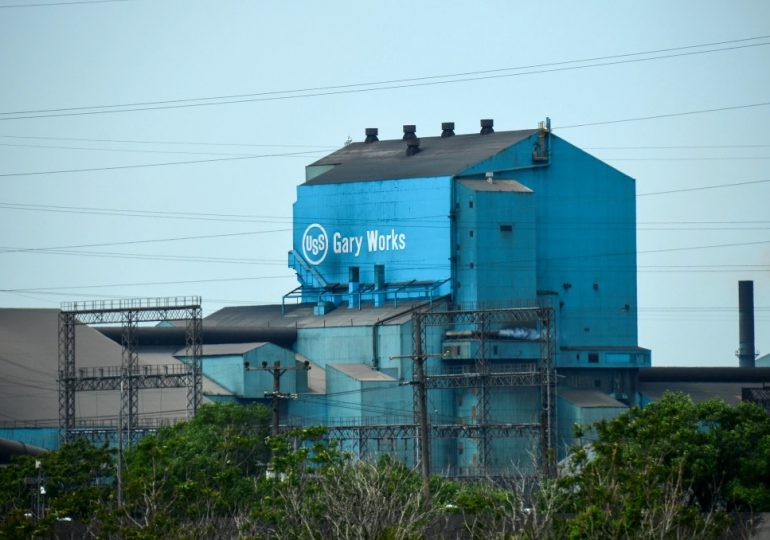A prospective buyer’s recent commitment to reinvest in a Gary, Indiana, steel plant sought to address union and government leaders’ worries about the sale’s potential impact on jobs and U.S. steelmaking capacity.
The plan to extend the life of the country’s largest and most carbon-emitting coal-fired blast furnace, however, has also heightened concerns from Northwest Indiana residents most affected by the facility’s air pollution.
“This is not acceptable,” said Susan Thomas, director of legislation and policy for Just Transition Northwest Indiana. “We now have technology for doing this much more sustainably.”
A study released Monday quantifies the public health threat highlighted by local clean air advocates, linking the Indiana plant to dozens of annual emergency room visits and premature deaths, as well as thousands of asthma attacks.
Japan-based Nippon Steel is seeking approval from U.S. regulators for a $15 billion acquisition of U.S. Steel, the storied domestic steelmaker whose facilities include the Gary Works plant in Northwest Indiana, along with others in Ohio, Michigan and Pennsylvania, key battleground states where the proposed sale has been a subject of presidential campaign. Vice President Kamala Harris and former President Donald Trump oppose the sale, as does President Joe Biden.
Much of the public discussion around the proposed sale has centered on its economic and national security implications, but those living near the plant have different concerns and demands. They say they’ve suffered for too long from steel industry pollution, and they only want Nippon as a neighbor if the company installs a new type of furnace that burns with lower or even zero emissions.
“I would love to see Gary Works transform to green sustainable steel, bringing more jobs, cleaning up the area, that would be an amazing win-win,” said Libré Booker, a librarian who grew up near the mill. “The people have lived under these conditions for far too long. It’s definitely time for a change.”
Gary Works is the largest integrated steel mill in North America, employing about 2,200 people. Northwest Indiana is also home to two other steel mills — Burns Harbor and Indiana Harbor — and two coke plants that turn coal into the high-density raw material for steel.
The populations in a three-mile radius of the Gary Works and Indiana Harbor steel mills are 96%-97% people of color, and almost two-thirds low-income people. The new study by Industrious Labs, a nonprofit focused on emissions reduction, used the EPA’s COBRA model to find emissions from the Gary Works plant likely are linked to 57-114 premature deaths, 48 emergency room visits and almost 32,000 asthma attacks each year.
The report cited the mills’ and coke plants’ emissions of sulfur dioxide, nitrogen oxides, carbon monoxide, particulate matter, and lead, all pollutants with direct impacts on public health. Gary Works is the number one emitter of PM2.5 particulate matter in the state, according to the company’s self-reported data analyzed by Industrious Labs.
Industrious Labs steel director Hilary Lewis said the results bolster the demands of clean steel advocates, who want to see coal-fired blast furnaces replaced by direct-reduction iron, or DRI, furnaces powered by hydrogen made with renewable energy, known as green hydrogen.
Booker was among 15 locals who participated in a recent “Sustainable Steel Community Cohort” run by Industrious Labs, attending five workshops learning about the science and policy of cleaner steel.
Green hydrogen, green steel
Green hydrogen is still not produced in large quantities anywhere in the U.S., and all the hydrogen currently produced in the country would not even be enough to power one steel mill, noted Seth Snyder, a partner in the Clean Energy Venture Group, at a recent conference in Chicago focused on clean hydrogen.
But DRI furnaces can be powered by natural gas, which results in much lower emissions than coal. Cleveland Cliffs — which owns the Indiana Harbor and Burns Harbor mills — is transforming its Middletown, Ohio steel mill to gas-burning DRI with the help of a $500 million incentive under the Inflation Reduction Act. The company says the conversion will make it the steel mill with the lowest emissions in the world.
With some modifications, DRI furnaces can burn a blend of natural gas and hydrogen or almost entirely hydrogen, experts say, meaning investment in a gas-burning DRI furnace could be a step on the way to “clean steel.” Lewis and other advocates, however, say gas-burning furnaces are not their goal, and they want the industry to transition off fossil fuels entirely.
Hydrogen can be blended into fuel for traditional blast furnaces too, but the maximum emissions reductions that can be achieved that way are 21%, according to a paper on hydrogen-powered steel production in Europe by the Norwegian non-profit science organization Bellona.
Nippon has announced it would invest $300 million in restoring the aging blast furnace at Gary Works, keeping it running for another 20 years. Installing a DRI furnace, meanwhile, typically costs over $1 billion.
“There is a gap,” said Lewis. “But these companies have the funding available. They have the money to make these decisions, they’re just choosing not to.”
Incentives for change
The IRA incentives tapped by Cleveland Cliffs are no longer available, but this summer California U.S. Rep. Ro Khanna introduced the Modern Steel Act, which would provide $10 billion in low-cost loans and grants, plus tax breaks and other incentives for new and revamped low-emissions steel mills, including hydrogen-fueled DRI.
Separately, lucrative tax credits soon to be available for “clean hydrogen” under the IRA could also make hydrogen-powered steel more financially viable. The specific rules for the tax credit — known as 45V — are still being finalized, amid controversy over what should qualify a project’s hydrogen as “clean.”
“There are a number of different incentives in the IRA that can help steel companies build out their own green hydrogen infrastructure,” Lewis said. “Everything should be on the table. Steel companies would be such huge off-takers for green hydrogen, they can build their own economy here.”
At the BP Whiting oil refinery, 10 miles from Gary Works, there are plans underway for production of blue hydrogen, or hydrogen made with natural gas followed by capture and sequestration of the emissions. The plan is a marquee part of the Midwest (MachH2) hydrogen hub, one of seven planned hubs nationwide slated to receive $7 billion total in federal funding. Such blue hydrogen could be used to power a steel mill, with theoretically no resulting greenhouse gas or public health-harming emissions.
However, local environmental and public accountability leaders are strongly opposed to blue hydrogen production in the region, since carbon sequestration has not yet been done successfully on a large scale in the U.S., and it would entail pipelines carrying carbon dioxide from the refinery to a sequestration site.
“The carbon capture component makes us very nervous, it seems to me they’re rushing into this without really taking the time to study it more seriously,” said Northwest Indiana resident Connie Wachala, another graduate of the sustainable steel program. “That might be because of all the money DOE is making available to industry. I wish our elected and industry officials would start thinking more creatively about how to make [green hydrogen] happen, how to make things better for the people in the neighborhoods and around the steel mills as well as for the shareholders.”
A different future
All four of Wachala’s grandparents came from Poland to work in the steel mills.
“Growing up in the 1950s, I remember my mom hanging the laundry up in the yard on a clothes line. If the wind was blowing a certain way, you’d get black particles on the clothes,” remembered Wachala, who worked as a creative writing teacher before retiring. “My dad’s car was always covered with that soot.”
Booker’s mother worked as a crane operator at the now-closed Bethlehem Steel mill in Burns Harbor, Indiana — among the first wave of women of color to be hired.
“I was proud she worked in the mill and took care of us, but I did not want [that job] whatsoever, seeing her come home every night after the swing shift, with the big old boots and jacket,” said Booker. “I wanted to go to college. It was a source of contention with my mom and I for some years.”
That was in the days when locals largely believed, “if you want a good partner, you’ve got to get one that works in the mill,” she continued. “It was like a prestigious job and position. People looked up to people who worked in the mill.”
Now, Booker laments, “Gary is like a joke,” scorned for its economic decline since the steel industry automated and shrunk — hemorrhaging jobs, and for the pollution that is still emitted. If the merger with Nippon does not go through, it’s widely believed U.S. Steel would eventually close the mill, as it closed its South Works plant in Southeast Chicago decades ago. At their height, the South Works and Gary Works plants together employed about 40,000 people in the Chicago area.
Thomas wrote a frustrated rebuttal to the Chicago Tribune editorial board opining that the Nippon merger was crucial to Gary’s future. She and other local leaders say they don’t want the mill to close, but they can demand better than the extension of heavily polluting industry.
“It’s just perpetuation of this as a sacrifice zone,” said Thomas. “‘This is what you’ve always been, this is how we’re going to keep you.’ But that’s not going to fly anymore.”
Steelmaker’s bid to buy U.S. Steel would extend life of Indiana plant — along with its emissions is an article from Energy News Network, a nonprofit news service covering the clean energy transition. If you would like to support us please make a donation.
Leave a comment






